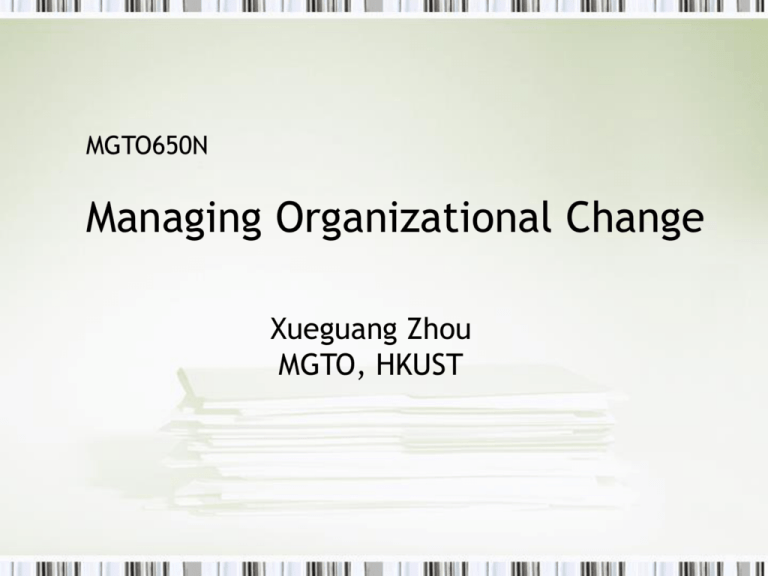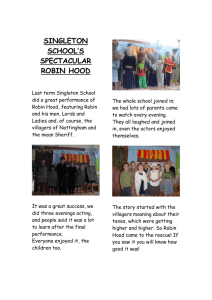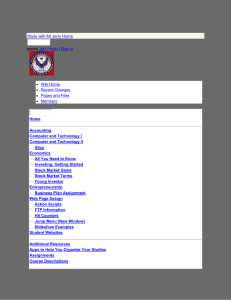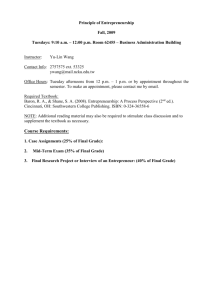Managing Organizational Change
advertisement

MGTO650N Managing Organizational Change Xueguang Zhou MGTO, HKUST Topics for today • House-keeping business • Question for discussion: – What are the challenges in organizational change? • Close-up: Lessons from 3M—a permanently changing organization • Analytical tools – Vocabularies, concepts, and models • Overview of the course What this course is about • Organizations change all the time – Disruptively, continuously – Intentionally, unintentionally • Why a course on organizational change – Instances of failures to change – Instances of successful turnarounds – Frustrations about change: at both ends of the table • Agents of change • Recipients of change Format and Requirements • Format: – – – – Instructor’s presentation Case study, team presentation Debate and class discussion Readings • Requirements – Class participation – Team project – Final examination • Formation of teams • Grading Q: What are the challenges for organizational change? • An observation: Most large companies at the beginning of the 20th century disappeared by the end of the century. Why? • Close-up: The case of Robin Hood – Populist rebellion against excessive tax collection – Rob from the rich and give to the poor – Established the camping basis in Sherwood Forest To this day, Robin Hood remains famous for bringing together the heroes inhabiting Sherwood Forest, but its growth has produced a new management challenge. Our task is to diagnose and propose ways to better address managing in this changing environment. Robin Hood • Is there a problem in Sherwood Forest? • What new options should be considered? • Which do you recommend? • In what ways has Robin Hood’s leadership style previously been most successful? • What are his weaknesses at this point? • Have you seen any of the types of management problems in this case in your own work experience? The organizational chart Robin Hood Will Scarlett Little John Scarlock Much the Miller’s Son intelligence discipline finance troop The band of Merrymen Issues related to “growing pains” • Increasing organizational size • Resources become scarce – Food supplies, finance • Change of mission, identity? – From confiscation to fixed transit tax • Increasing competition – The sheriff’s increasing threats • Strategic alliance – Conspiracy against Prince John? • Similar patterns in other types of organizations? The Five Phases of Growth Larry Greiner Organization Practices During Evolution in the Five Phases of Growth Category MANAGEMENT FOCUS PHASE 1 Make & Sell ORGANIZATION Informal STRUCTURE TOP MANAGEMENT STYLE CONTROL SYSTEM MANAGEMENT REWARD EMPHASIS PHASE 2 PHASE 3 PHASE 4 Efficiency Expansion of Consolidation of market of organization operations Centralized Decentralized Line-staff & & & product groups functional geographical Individualistic & Directive entrepreneurial Standards Market results & cost centers Salary & Ownership merit increases Delegative PHASE 5 Problem solving & innovation Matrix of teams Watchdog Participative Plan & Reports & investment profit centers centers Mutual goal setting Individual bonus Team bonus Profit sharing & stock options Organizational Change Exercise 1. The overall phase (of Greiner’s five) in which I see my organization now is: 1 2. 4 5 2 3 4 5 Which of these phases have you seen it move through? 1 4. 3 In 10 months, the phase in which I anticipate my organization will be is: 1 3. 2 2 3 4 Think back on how the transitions were accomplished. 5 Questions for discussion 1. Why is it difficult to change? 2. What is your experience regarding change? Issues related to organizational change • Strategic— – Leadership: visions, anticipatory action – strategies in timing,, initiation, coalitions & mobilization • Political – Vested interests—the politics of change • Structural – The power of organizational routines – Informal networks • Cultural – Stability in experience, expectations – Psychological contracts STRATEGIES OF ORGANIZATIONAL CHNGE 1. Change or Stability? 2. Change from strength or from weakness? 3. Change from top-down or from bottom-up? 4. Using existing structure or creating new structure? 5. Clear goals or ambiguous goals? 6. Focus on short-run gains or long-term goals? 7. Incremental changes or discontinuous changes? Case study: 3M: The Permanently Changing Organizations • One of “the ten most admired corporations” — Fortune annual poll of American CEOs. • The 3M model: – Continuous technological innovation – Institutionalized “individual entrepreneurship” – Market responsiveness • • • • How is this possible—what are the challenges? Institutionalized “individual entrepreneurship”? Growth versus decentralization? Balance between structure, culture, versus change? 3M: A brief history • Established in 1902, producing abrasives and adhesives products. – Benefited from product innovation in the early days – The culture of “individual entrepreneurship” • The McKnight era, 1929-1966 – Organizational design for continuous changes • The Lou Lehr era, 1980-1985 – Reorganization and reorientation • The “Jake” Jacobson era: 1986-1991 – The orientation to competition in existing markets • Main characteristics: – Changes and evolution in adaptation to environments – Changes in organizational attributes for innovation Challenge 1: Entrepreneurship versus structure • Innovation – the spirit of entrepreneurship – Competition through new products – Competition through new niches • The dilemma between entrepreneurship and structural differentiation • The 3M way: – – – – External demands and internal capabilities Decentralization: locus of decision at lower lab units; Organizational design to facilitate lateral communication The strategy of growth through new niches, rather than competition in existing markets. Challenge 2 The role of organizational culture • Organizational culture: norms, expectations, and tacit knowledge • The 3M way: – Innovation is the center of organizational culture – Resistance to bureaucratic intervention is encouraged; – Contribution to innovation is greatly respected—legends, institutional memories, ceremonies. • Structure versus culture – Cultural: The value of knowledge sharing – Structural: Technical Council, Technical Forum, lateral interaction Challenge 3 Human resource practice • The roles of rewards and incentives • The role of loyalty for 3M • The 3M way: – Rewards for innovation – Dual track of promotion and recognition – Tolerance of “well-intentioned failures” Mistakes will be made, but if a person is essentially right, the mistakes he or she makes are not as serious in the long run as the mistakes management will make if it is dictatorial and undertakes to tell those under its authority exactly how they must do their job. Management that is destructively critical when mistakes are made kills initiative, and it is essential that we have many people with initiative if we are to continue to grow. William L. McKnight Challenge 4 Leadership and Strategic Vision • The role of leadership – Allowing failures – Patient with experimentation • Strategic visions – The link between structure, culture, and growth strategies – The evolution of strategies • The 25% rule • From single market to multiple markets • From new market niche to competition in existing markets Unanswered Questions • Politics in organizations – Vested interests in existing technologies, products – Competition, turf wars among labs, divisions • Culture: – How is it sustained with the flow of people in organizational growth? • The costs of innovation – Failures, start-up costs, learning curves – Demands for new structures, resources • Organizational Life Cycle – Entrepreneurship, expansion, structural differentiation, and associated challenges • Changes in environments – Imitation-competition from other companies Three Lenses to “see” Organizational Change Political: interests coalitions resources/power Cultural: artifacts values assumptions Strategic: leadership timing process alignment The strategic lens • Organization as a system designed to achieve certain goals; • Focus on principles for organizational design – – – – – – Strategic intent Linking strategy and organization Strategic grouping Strategic linking of jobs, departments, and functions Alignments of rewards & incentives with grouping Fit between organization and environments Processes in strategic design Assess environment (Threats and opportunities Industry analysis, etc.) Strategic Intent Assess organization (Core competences, Organizational capacities) Strategic Organizational Design (grouping, Linking, Alignments) The political lens • Organization as a political coalition • Identify and map relationships among stakeholders, and their different interests and goals • Focus on – – – – – sources and strength of power distribution of resources coalition building bargaining processes The Stakeholder Model Professional Community Shareholders Top Managers Researchers Customers FIRM Local Community Workers Middle Managers Suppliers Unions Public interest groups (e.g., environmental groups) Banks/Creditors The cultural lens • Organization as a system of symbols and meanings • The importance of history and interpretations • Official culture versus subculture • Formal authority versus informal social control • Cultural context and strategic design Three Lenses to “see” Organizational Change Political: interests coalitions resources/power Cultural: artifacts values assumptions Strategic: leadership timing linking process Goal of the course: A repertoire of managerial skills • Vocabularies – how do we talk about changes? – Issues: leadership, coalition building, culture, etc. • Analytical models – how do we analyze changes? – Political – Cultural – Strategic • Hand-on practice—how do we manage changes? – Case studies – Simulation – Debates, brainstorm, collective diagnosis Outline of the Course 1. Why Change? Session 1. Issues related to organizational change Session 2. Leadership in organizational change 2. Processes of Organizational Change Session 3. Individual level: agents and incentives Session 4. Interpersonal: Social relations and culture Session 5. Putting things together: the EIS simulation Session 6. Organizational: Strategic dimensions 3. Summary and Reflections Session 7. Strategies of organizational change Session 8. Final examination Key Takeaways – Managing Growth • Know where you are in the development cycle. • Be prepared to dismantle current structures before a crisis hits. • Realize new solutions breed new problems. • Continually strive to become a learning organization. Different images of organizations • Organization as a system for rational design • Organization as a political coalition • Organization as a system of symbols and meanings • What are the implications for understanding organizational changes? • What are the implications for managing changes in organizations? Overview of the course Strategic Culture design Leadership Agents Recipients Politics







